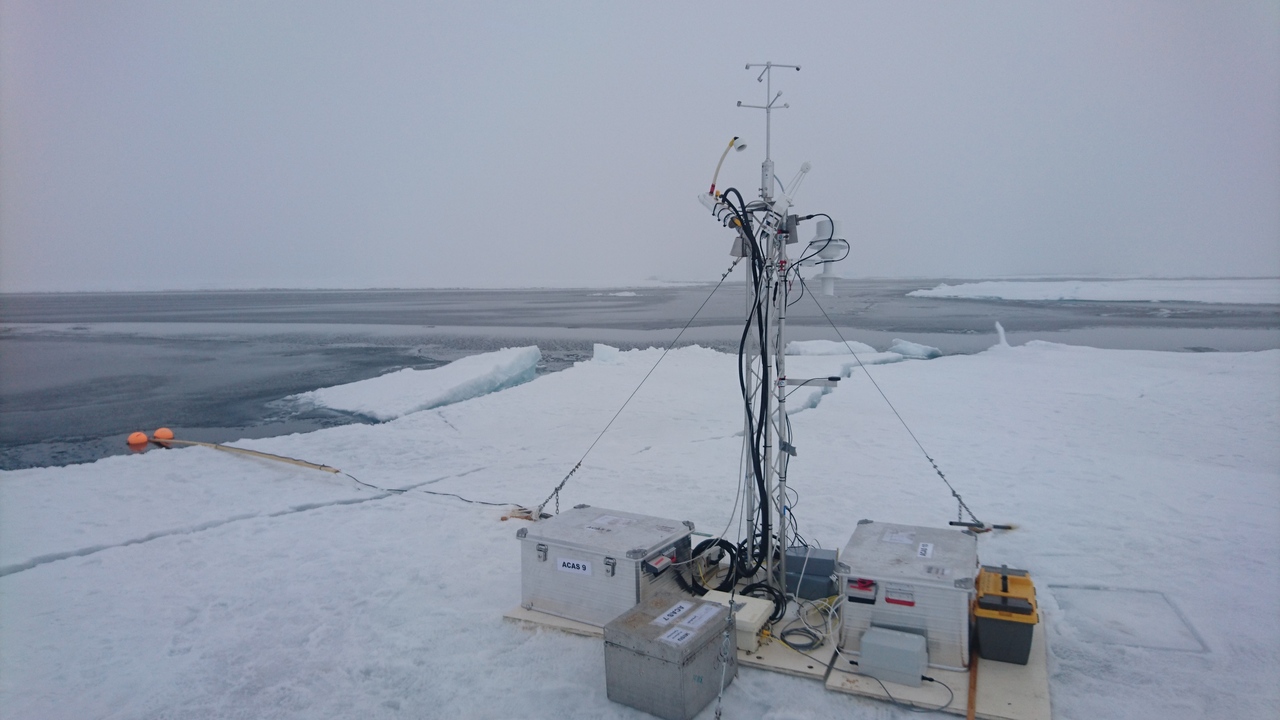John Prytherch
Air-sea fluxes of momentum, heat and CO₂, associated micrometeorological and mean meteorological and ocean surface variables. Fluxes are derived from fast response (20 Hz) measurements of the 3-dimensional wind vector, temperature humidity and CO₂ using eddy covariance.
These are direct measurements of air sea exchange from sea-ice regions of the Arctic Ocean. They are key parameters in numerous processes, for example, air-sea gas transfer and determination of the surface energy balance.
The measurements are from instrumentation mounted on a 2-metre high mast adjacent to a sea-ice lead, approximately 1.5 km from icebreaker Oden’s location during the Arctic Ocean 2018 (AO2018, also referred to as MOCCHA-ACAS-ICE) expedition to the central Arctic Ocean in August and September 2018. Eddy covariance fluxes are determined on 30-minute intervals.
Note that this is an outdated revision of the dataset and there is an
updated version.
Citation
John Prytherch (2020) Micrometeorological data from an ice-floe adjacent to an open lead during the Arctic Ocean 2018 expedition. Dataset version 5. Bolin Centre Database. https://doi.org/10.17043/oden-ao-2018-micromet-icefloe-5
Data description
Micrometeorology data from the open-lead mast, averaged over either 1 or 30-minute intervals. Flux data are not included in the 1-minute files. Spectra data for each 30-minute flux period. System operated by John Prytherch (MISU). Three data formats are available: Matlab (.mat), NetCDF (.nc) and comma separated value (.csv) text, with an accompanying readme (.rtf) file. Spectra are provided in Matlab and text formats.
Comments
The instrumentation on the open lead mast consisted of a Metek uSonic-3 heated sonic anemometer, a LI-COR 7500 infrared gas analyser, a LI-COR 7200 infrared gas analyser and pump, a Heitronics KT15.IIp infrared temperature sensor, an aspirated TRH sensor, a TSI 3762 CPC, a GPS unit and a Pro-Oceanus CO2-Pro CV pCO₂ sensor. Power was provided by 12V batteries, exchanged daily.
The majority of the fast-response instrumentation measured at 20 Hz. Atmosphere-surface fluxes were determined from the fast-response measurements using eddy covariance. All wind measurements are ice-relative (no correction for ice-drift velocity). Anemometer winds have an aliasing correction applied prior to flux calculation, removing all signal above 5 Hz.
Condensation particle counter (CPC) particle number concentrations will be published in separate data sets and are not included here.
The surface through which the measured flux is occurring will depend on the wind direction and the (highly variable) dimensions of the open lead. Lead dimensions were measured throughout the expedition and flux footprint analysis will be published with a subsequent version of this dataset. Surface temperature measurements from the mast infrared sensor were primarily of the lead surface water (excluding periods when drifting ice was in the sensor field of view). Measurements of ice-surface temperature (from an infrared sensor mounted on Oden) are also included in this dataset for reference.
Quality control flagging follows Foken et al. (2012): Chapter 4 in Eddy Covariance: A practical guide to measurement and data analysis (eds. M. Aubinet, T. Vesala, D. Papale), Springer Atmospheric Sciences, and references therein: Foken and Wichura (1996) and Vickers and Mahrt (1997). Some of the code implementing these was adapted from the Eddycalc suite.
Data from the open-lead mast are combined into a cruise-length file. The data are time-averaged to both 1-minute and 30-minute intervals. Flux data are not included in the 1-minute files.
Version history
Version 5
Includes CO₂ flux and gas exchange parameters and spectra.
Version 4
Removes the sonic 5 Hz aliasing correction, which is not necessary for these ice station measurements. This version is not published.
Version 3
Corrects an error in the quality control of the open-path Licor 7500 IR gas analyser.
Version 2
Initial release.
Version 1
Not published.
Image caption
The micrometeorology mast at the open lead site, approximately 2 km from Oden’s mooring. The Metek uSonic-3 sonic anemometer is attached to the top of the mast with a measurement height of 2.55 m above ice level. The two infrared gas analysers (open path LI-COR 7500, close path LI-COR 7200) are below it, with a Heitronics KT15.IIp infrared temperature sensor, an aspirated TRH sensor, and the inlet for a TSI 3762 CPC. A GPS unit is mounted below these on a small boom. The Pro-Oceanus CO2-Pro CV pCO₂ sensor is mounted below the orange floats in the open lead at 0.5 m depth.
GCMD science keywords
Earth science > Atmosphere
GCMD location
Ocean > Arctic Ocean
Project
Arctic Ocean 2018. These data are part of the Arctic Climate Across Scales (ACAS) project, funded by the Knut and Alice Wallenberg Foundation. Project PI Michael Tjernström (MISU). The project was also partly funded by the Bolin Centre for Climate Research.
Publisher
Bolin Centre Database
DOI
10.17043/oden-ao-2018-micromet-icefloe-5
Published
2020-02-28 17:30:20
